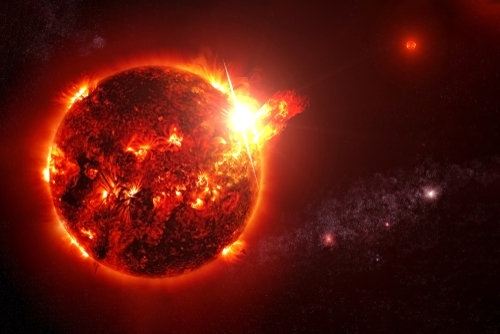
As the cosmos continues its eternal dance, Earth finds itself in the path of a celestial spectacle that doubles as a cautionary tale. Two significant solar eruptions have occurred, with the first set to make landfall on our planet’s atmosphere by Monday afternoon, followed closely by a second impact expected shortly thereafter. These solar storms, consisting of energized particles hurled from the sun, remind us of the delicate balance between the marvels and the perils of space weather.
The first of these solar tempests is predicted to strike no earlier than 1 pm ET on Monday, with the second arriving by Wednesday. The Space Weather Prediction Center (SWPC) has issued an alert for a moderate G2 geomagnetic storm, which could lead to stunning auroral displays as far south as northern Wyoming, South Dakota, Iowa, Wisconsin, Michigan, New York, New Hampshire, Vermont, and Maine. While the general public need not worry, there is a 60% chance of radio blackouts affecting GPS and other communication systems, particularly on the dark side of the planet and at higher latitudes.
Two explosions from the sun set to impact Earth from TODAY
@elonmusk Any truth to this story ?? https://t.co/fKGE0Hh9JO— Lana (@LanaAdams818) January 22, 2024
Space weather experts have highlighted potential disruptions to power grids, aviation communication, ham radios, and satellite operations. The charged particles can interfere with high-frequency radio waves, temporarily drowning out satellite signals. This phenomenon is akin to the sun “screaming” at us during a solar flare, overpowering the “chirp” of our satellites. The impact is most likely to affect aviation communication, government time stations, weather stations, amateur radio, and citizens band services.
Sunspot activity is at the heart of these solar events, with sunspots 3559 and 3555 releasing coronal mass ejections (CMEs) just one day apart. These CMEs can eject billions of tons of corona material, composed of plasma and magnetic fields, into space. Such eruptions have the potential to trigger space weather that can interfere with satellites and power grids on Earth and can be harmful to unprotected astronauts.
Two explosions from the sun set to impact Earth from TODAY – with a 60% chance of GPS blackouts in certain parts of the world
via https://t.co/JJgrrHwHNg https://t.co/WrVU4x4lWC— thaiparampil (@thaiparampil) January 22, 2024
The SWPC’s scale classifies the expected geomagnetic storm as moderate, but it still warrants precautions. Voltage corrections may be necessary, and false alarms could trigger some devices. Satellites and spacecraft in orbit may experience increased drag, potentially affecting their operations. It is a stark reminder of our reliance on technology and the importance of preparing for space weather events.
Despite the potential for disruption, these solar storms also bring with them a natural wonder—the aurora borealis, or northern lights. These mesmerizing light shows are a testament to the beauty of our universe and the complex interactions between our planet and the sun. As the charged particles collide with Earth’s magnetic field and atmosphere, they create a dazzling display of colors that captivate onlookers.
In response to these impending solar events, it is crucial for those in affected industries to monitor the situation closely and take necessary precautions. Amateur radio operators, pilots, and others who rely on high-frequency communications should be prepared for possible interruptions. Meanwhile, power grid operators are advised to stay vigilant and ready to implement corrective measures if needed.
As we brace for the impact of these solar storms, we are reminded of our place in the vast expanse of space. While we marvel at the wonders above, we must also respect the forces at play and prepare accordingly. The dual nature of these solar events serves as a humbling lesson in both the awe-inspiring and disruptive power of our star, the sun.













